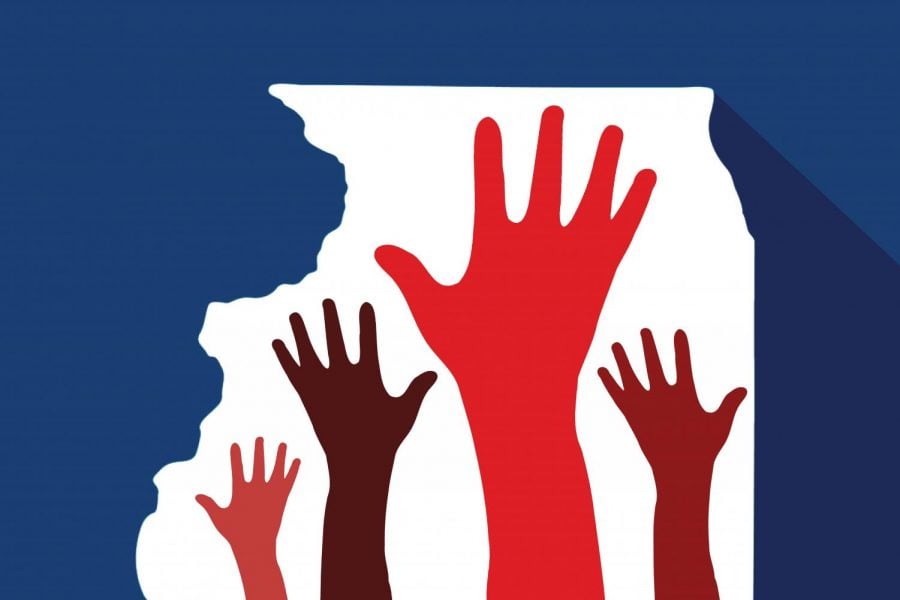Hard to Count: The fight to prevent a 2020 undercount amid COVID-19
Graphic by Catherine Buchaniec
Amid COVID-19, local organizations are working to prevent an undercount, especially within ‘hard-to-reach’ communities.
April 16, 2020
Once a decade, the U.S. government attempts to count all Americans — but not every American is easy to reach, and an undercount can have enduring consequences for those the government misses.
The United States Census Bureau defines hard-to-count communities as those who face barriers to inclusion in census counts, including communities of color, those experiencing homelessness, immigrants, LGBTQ communities and the elderly.
In 2010, the black population in the United States was undercounted by an estimated 2.1 percent, and the Hispanic population by 1.5 percent. In contrast, the white population was overcounted by 0.8 percent, according to the Census Bureau.
The 2020 Census not only determines the distribution of political power, but also directs over $1.5 trillion in federal funding toward resources like healthcare, unemployment services, schools and food stamps, according to Beth Lynk (Communication ‘11), director of the Census Counts campaign at the Leadership Council on Civil and Human Rights.
“(Undercounted groups) that have been missed decade after decade lose out on the federal funding that they deserve, and the political power that they should receive as their fair share,” Lynk said.
As of Thursday, Evanston had a 59.1 percent overall self-response rate, with parts of the 5th and 1st Wards participating around 10 to 15 percent less than other wards. The self-response rate nationwide was 49.4 percent.
“Those are not bad numbers for where we are right now,” said Willie Shaw, the political action and civic engagement chair for the Evanston/North Shore branch of the NAACP. “The census is going to be extended … that’s going to get us some more time. Hopefully, we’ll be able to get out more in terms of canvassing and door-to-door and having some forums.”
In 2010, Evanston’s final self-response rate was 72.8 percent, with the rest of the responses coming from enumerators, who are employees of the Census Bureau tasked with going door-to-door and interviewing residents at their homes.
Before COVID-19, the canvassing period was set to begin in mid-May. However, the Census Bureau has recently pushed the in-person phase of data collection back to August, according to a news release. Shaw said as of now, it’s too soon to predict the complete effects of COVID-19 on the census — but she said self-response numbers are slightly higher to date than they were at this time ten years ago.
The Evanston/North Shore NAACP branch is an official Complete Count partner for the 2020 Census. Shaw said the organization is working to encourage African American and Latinx census participation, alongside other hard-to-count communities in the area.
While coronavirus concerns necessitated the cancellation of the organization’s scheduled Complete Count kickoff at the end of March, Shaw said members of her organization are still encouraging individuals to self-respond. Members are taking to social media, calling individuals through phone banks and even posting yard signs to spread the word about the 2020 Census, she said.
Shaw said those who lack internet access can fill out census forms — set to arrive in the mail this week — or call the Census Bureau to complete the questionnaire.
Lynk said communities of color and low-income communities are usually best reached through door-to-door canvassing, the period in which enumerators arrive in person to residences that have not yet self-responded to the Census. She also said her organization works to ensure enumerators represent the demographic makeups of communities.
For groups already facing low census representation, the COVID-19 pandemic and a delay in the enumeration process presents the possibility of an even greater count disparity.
As a result, minority-focused organizations such as the Chicago Urban League are continuing to promote online participation as well. Kareem Butler, the group’s 2020 Census project coordinator, said he is aware that communities the league is working to reach may not have the option to participate online or by phone.
As an alternative, Butler is reaching out to Chicago Urban League’s current and former clients to inform them about an offer allowing people to access the internet for 60 days free of charge. He said informing people without internet service about the offer can be challenging, but he hopes communities will spread the word, allowing people to remain connected.
He said this year, more than ever, the census is essential for communities who are traditionally undercounted.
“The census, especially this one, is going to really be helpful towards generating federal dollars that go toward health care and all sorts of different programs that are going to be useful and more necessary than ever in dealing with the aftermath of (COVID-19),” Butler said. “We do have some real problems that we have to talk about, and that’s why it’s more important than ever that people fill out the census.”
Email: maiaspoto2023@u.northwestern.edu, jacobfulton2023@u.northwestern.edu
Twitter: @maia_spoto, @jacobnfulton1
Related stories:
— As census self-response period opens, local organizations evaluate outreach methods during COVID-19



